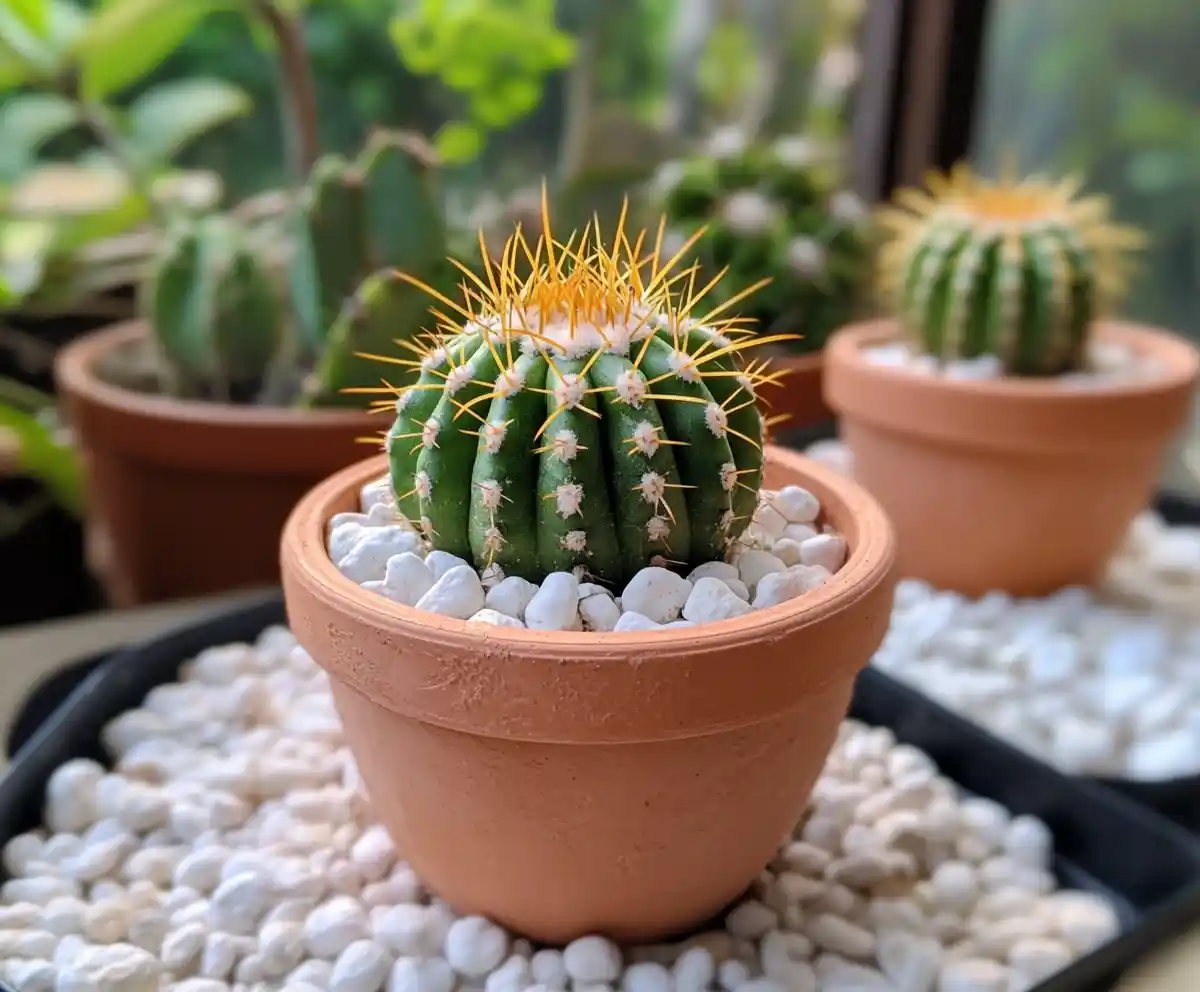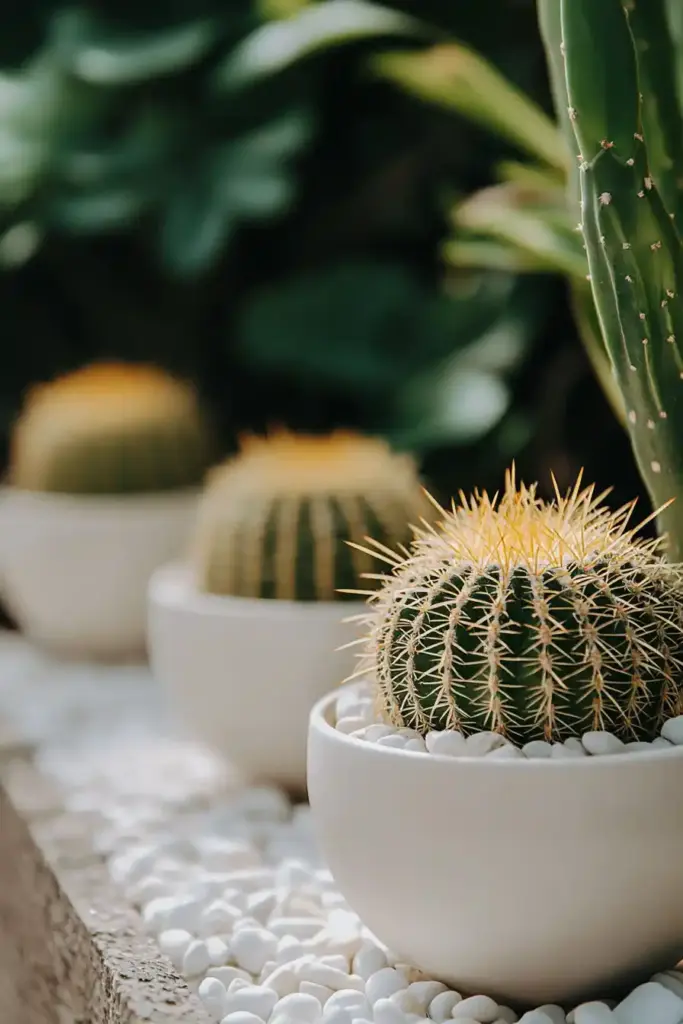Cactus plants are fascinating, low-maintenance additions to any garden or indoor space — but not all cacti are the same! 🌵 Many beginners assume that every cactus has similar needs, only to discover a huge variety when they visit a nursery for the first time. In fact, the cactus family includes a wide range of species, each with its own unique characteristics and care requirements.
If you’re thinking about adding a cactus to your home, you’re in luck. In this guide, we’ll explore the 4 most common types of cactus plants that you can grow, including helpful tips to ensure they thrive in your space. Whether you’re a seasoned plant lover or just starting out, these iconic cacti are perfect for your collection!
1. The Golden Barrel Cactus (Echinocactus grusonii)
The Golden Barrel Cactus is one of the most striking cacti you can grow, known for its globe-like shape and bold, yellowish spines. Its ribbed body gives it a distinct desert charm that’s perfect for sunny patios, conservatories, or indoor spaces with plenty of light. While it rarely blooms, its plush, woolly crown and classic “cactus look” make it a favorite among gardeners. Plus, its dramatic appearance adds an exotic touch to any plant collection!
Important Note: Those spines are not just for show — they can cause serious injuries if handled improperly, so always place this cactus out of reach of children and pets.
Growing Tips
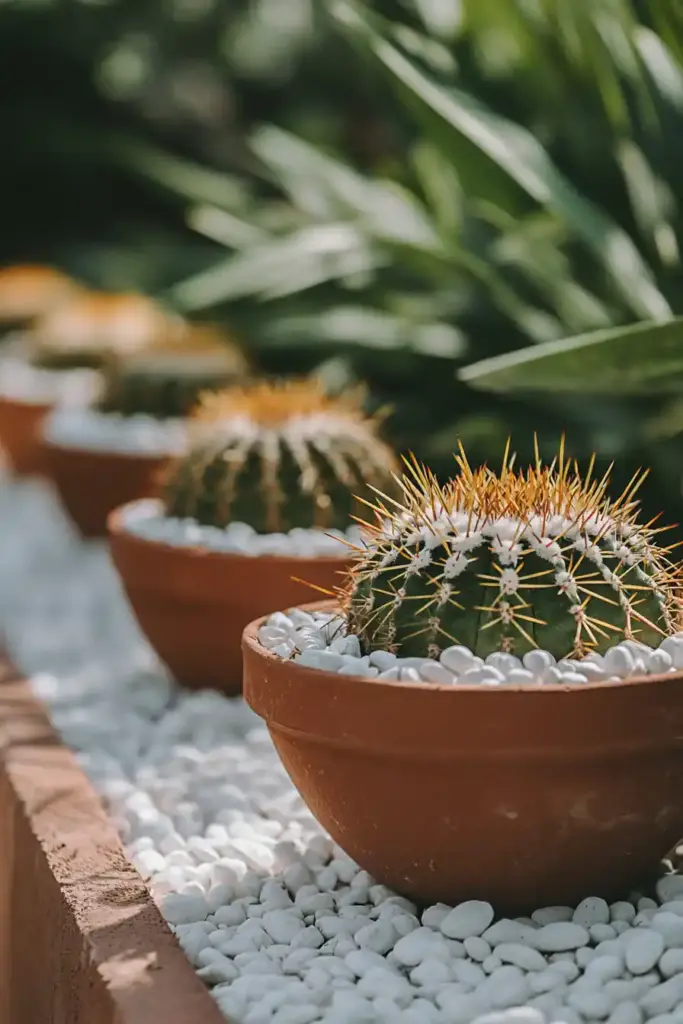
- Sunlight: Needs full sun exposure to flourish.
- Temperature: Ideal range is 50°F to 75°F (10°C to 24°C). Protect from frost — anything below 40°F can be damaging.
- Watering: Water sparingly during the growing season (spring to fall) and completely stop watering in winter to avoid root rot.
- Planting Tip: Give it enough room to grow — don’t overcrowd it with other plants.
Care Tips
- Soil: Use a gritty, well-draining cactus mix to prevent soggy roots.
- Fertilizer: Feed with a high-potassium cactus fertilizer once a month during summer for best results.
- Extra Advice: Consider using the Golden Barrel Cactus as a natural “security plant” under windows — its spines are a great deterrent!
2. Prickly Pear Cactus (Opuntia)
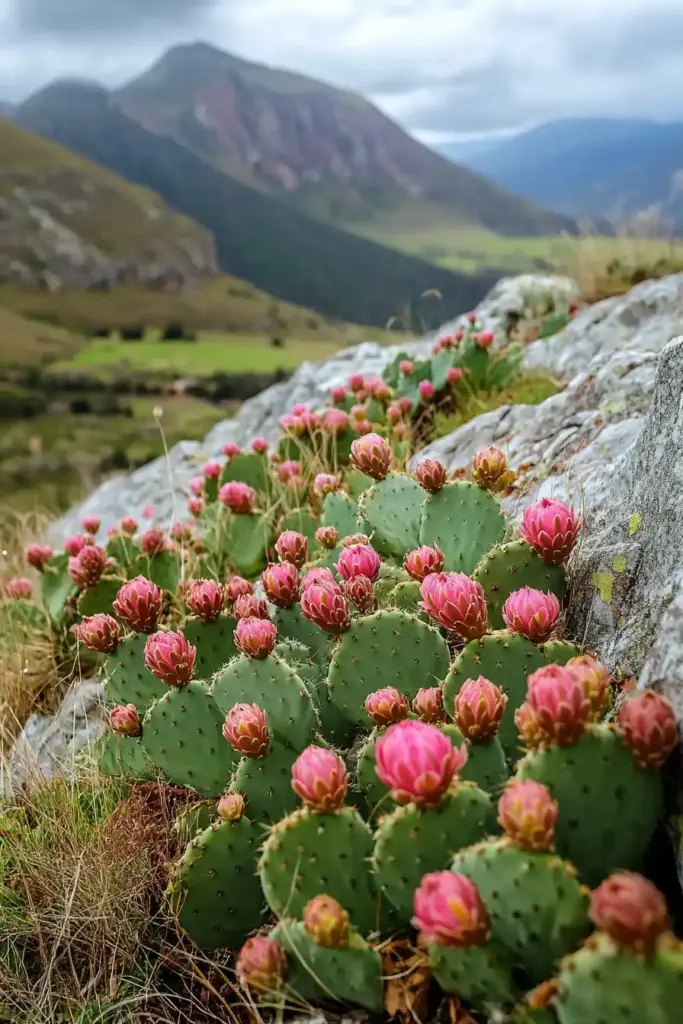
The Prickly Pear Cactus — also known as Opuntia or “paddle cactus” — stands out with its wide, flat, branching pads. These pads aren’t just unique in shape; they’re also edible, along with the vibrant flowers and fruits the cactus produces. Bursting into brilliant shades of orange, yellow, and red, the Prickly Pear’s blossoms bring a pop of color that’s worth the wait. However, beware: the plant’s tiny spines (called glochids) can cause irritation if touched.
Growing Tips
- Propagation: Start from cuttings or seeds, ideally in spring or summer.
- Sunlight: Loves full sun exposure for healthy growth and flowering.
- Soil: Prefers well-draining soil — never let it sit in waterlogged conditions.
- Planting Tip: When transplanting, keep the pad at the same depth it was originally growing to avoid rot.
Care Tips
- Watering: Once established, water only every 3–4 weeks. Avoid watering newly planted cuttings for the first month.
- Soil pH: Thrives best in alkaline to neutral soil.
- Fertilizer: Use a balanced 10-10-10 fertilizer for young plants. Mature plants benefit from a 5-10-10 or 0-10-10 formula to encourage fruit and flowers.
- Bonus: Prickly Pear is remarkably pest-resistant but ensure proper drainage to avoid root rot.
3. Saguaro Cactus (Carnegiea gigantea)

The Saguaro Cactus is the legendary giant of the Sonoran Desert, instantly recognizable by its towering height and iconic arm-like branches. Known scientifically as Carnegiea gigantea, this cactus can live up to 200 years and grow as tall as 60 feet! Although a young saguaro may only be a few inches tall after a decade, with patience and the right care, it becomes a stunning, long-lived centerpiece for your garden or indoor plant collection.
Growing Tips
- Sunlight: Thrives with plenty of direct sunlight. If growing indoors, place near a bright, south-facing window.
- Temperature: Keep it warm — it should never be exposed to temperatures below 60°F (16°C).
- Soil: Well-draining cactus soil is essential to prevent root rot.
- Indoor Tip: Move the plant indoors before cold weather arrives if you live in a cooler climate.
Care Tips
- Watering: Moderate watering during the growing season (spring to early fall). Cut back in winter to mimic its natural dry season.
- Fertilizer: Feed every 2–3 weeks during spring and summer with a cactus-specific fertilizer to encourage healthy growth.
- Potting: Use smaller pots, as saguaros have delicate root systems. Only repot when absolutely necessary to avoid stressing the plant.
4. Rhipsalis Cactus (Mistletoe Cactus)
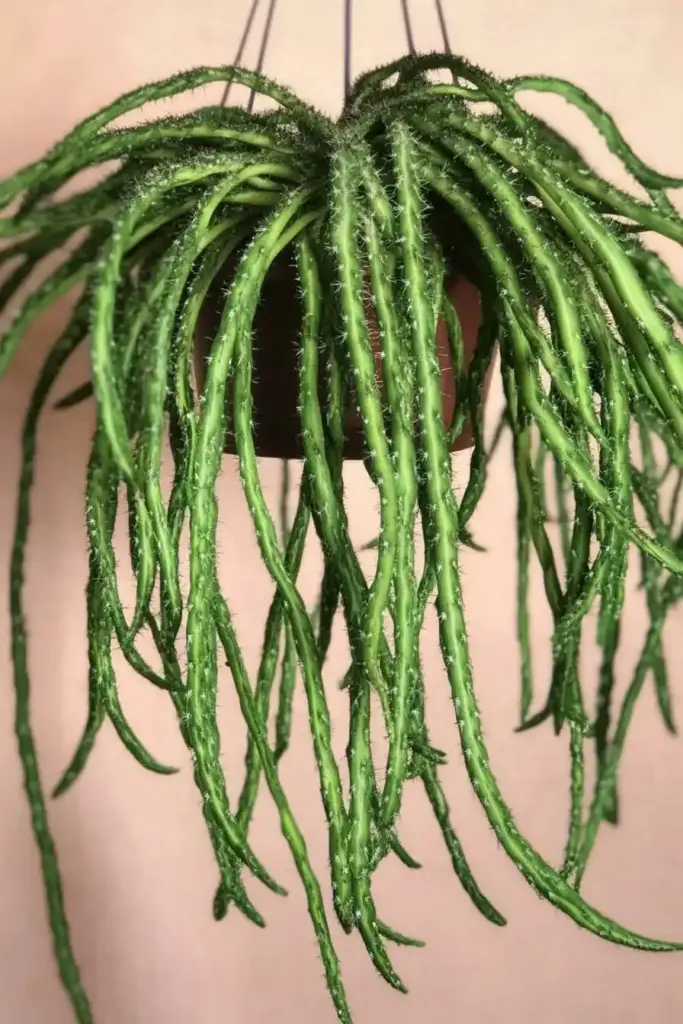
The Rhipsalis Cactus, commonly called the Mistletoe Cactus, is a charming, tropical variety unlike most desert-dwelling cacti. Native to rainforests, this epiphytic cactus grows long, cylindrical, trailing stems that create a soft, cascading effect. Instead of sharp spines, Rhipsalis features delicate, hair-like structures, making it a gentle and beautiful addition to hanging baskets or shelf displays.
Growing Tips
- Propagation: Best propagated from cuttings — seeds are tricky and slow to germinate.
- Soil: Use a light, well-draining potting mix. A blend of standard soil with coir, gravel, or orchid bark works beautifully.
- Sunlight: Prefers bright, indirect light — direct sun can scorch its tender stems.
Care Tips
- Watering: Water once a week, keeping the soil lightly moist but never soggy.
- Overwatering Alert: Avoid heavy watering, which can weaken the stems and lead to root rot.
- Fertilizer: Wait at least one year before fertilizing newly propagated plants. After that, use a diluted cactus fertilizer occasionally during the growing season.
Fun Fact: Unlike many cacti, the Rhipsalis loves humidity, making it an ideal choice for bathrooms or kitchens!
Frequently Asked Questions (FAQ)
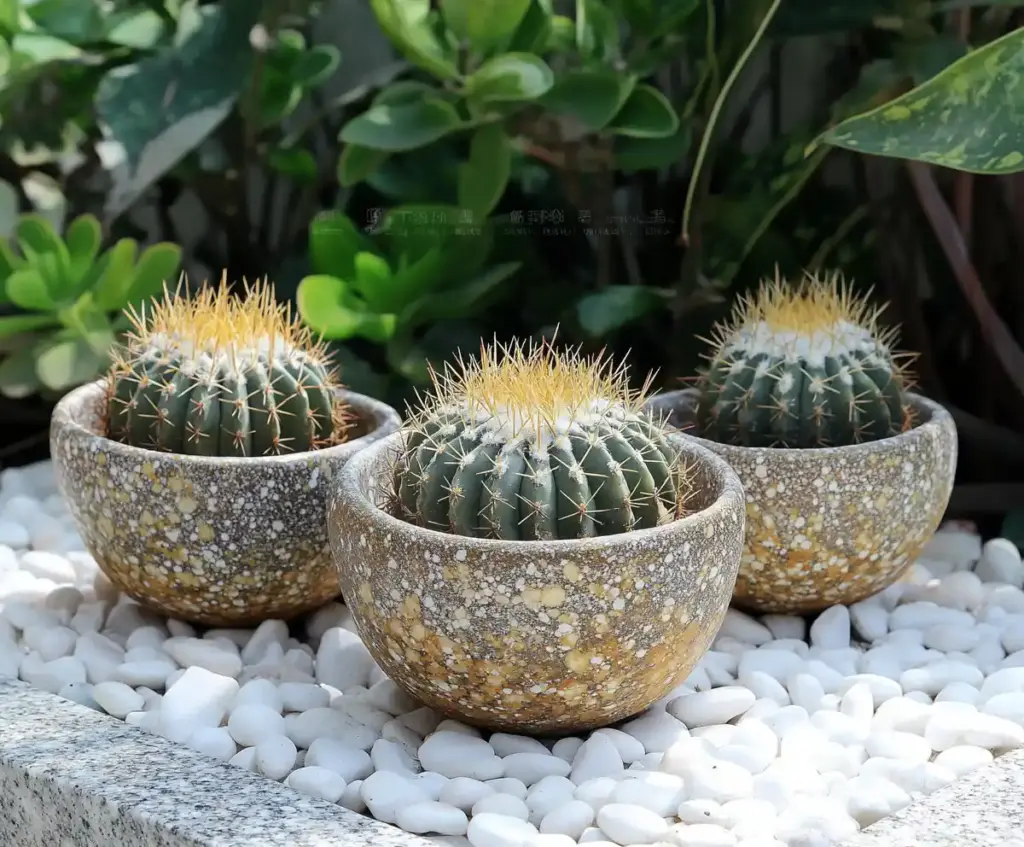
1. What is the easiest cactus to grow for beginners?
The Golden Barrel Cactus and the Prickly Pear Cactus are excellent choices for beginners. Both are hardy, low-maintenance, and thrive with minimal watering as long as they get plenty of sunlight and proper soil drainage.
2. Can I grow a Saguaro cactus indoors?
Yes, you can grow a Saguaro Cactus indoors, but it requires very bright light — ideally from a south-facing window. Keep in mind that saguaros grow very slowly, so it will remain small for many years, making it manageable for indoor spaces.
3. How often should I water my cactus plants?
Most cacti, including the Golden Barrel and Prickly Pear, need to be watered only once every few weeks during the growing season and even less in winter. However, tropical species like Rhipsalis prefer slightly more frequent watering — about once a week.
4. Do cacti need fertilizer?
While cacti don’t need heavy feeding, fertilizing during the growing season (spring and summer) can promote healthy growth and flowering. Use a specialized cactus fertilizer or a diluted low-nitrogen fertilizer for best results.
5. Can I plant different types of cacti together?
Yes, you can plant multiple cacti together if their light, water, and soil needs are similar. Be sure to allow enough space between them to prevent overcrowding and to highlight each plant’s unique shape and size.
Conclusion
Whether you’re a seasoned plant enthusiast or just beginning your cactus journey, growing these four popular varieties — the Golden Barrel Cactus, Prickly Pear Cactus, Saguaro Cactus, and Rhipsalis Cactus — can bring a unique and vibrant touch to your home or garden. Each has its own special charm and care needs, but all reward you with stunning beauty and resilience.
By choosing the right cactus for your environment and following simple care guidelines, you can enjoy these iconic plants for many years. Remember: sunlight, good drainage, and careful watering are your best friends when it comes to happy, healthy cacti!
Ready to add a cactus (or two) to your space? Start with one of these amazing varieties and watch your indoor garden thrive!

